This article contains affiliate links. We may earn a small commission if you purchase via these links.

While laser rangefinders have been very expensive in the past, you can welcome in the new era where they're more affordable than ever.
If you can land yourself a good steal, you'll be grabbing distances with ease on the green, at the range, and in the field.
Whether the sport of your choice entails a club, bow and arrow, or rifle, a laser rangefinder takes away the guess work for all!
QUICK LIST: 6 Best Rangefinders Under $150 In 2024
- Sig Sauer Kilo1000 5x20
- TecTecTec ProWild
- Simmons Venture 6x20
- Bushnell Bone Collector 850 LRF
- Halo XL450-7
- Sig Sauer Buckmasters 1500
Why Trust Us?
After hundreds of hours of hand-testing rangefinders in the field and at the range, and thousands more hours researching and writing about them, we feel we earn the title of experts when it comes to optics!
We purchase as many of the optics for our tests as possible, and run them through their paces to make sure they will perform at the range and in the field.
Our combined decades of experience from shooting sports and hunting, to big game hunting and competitions has been integral in putting together this round-up of the best rangefinder below $150.
Get the inside scoop on how we test optics here.
Best Budget Rangefinders Under $150
There was a day when laser rangefinders were heeded with weariness and skepticism, and the high prices for the new gadgets did nothing to help its debut. Now that they've had quite some time to be integrated into a variety of outdoor activities, they're sporting better than ever prices.
Of course you can find laser rangefinders that are extremely expensive and can even put your rifle scope to shame. But, it really doesn't take that much to land yourself a reliable and accurate one, even from some of the best names in the optics industry.
If you want dependability, great glass, and instant, accurate readings, we've got quite the line-up for you!
| IMAGE | PRODUCT | DETAILS | |
|---|---|---|---|
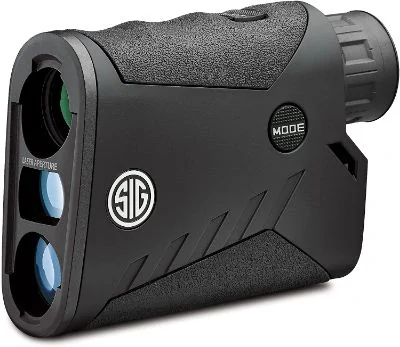 | Sig Sauer Kilo1000 |
| CHECK PRICE |
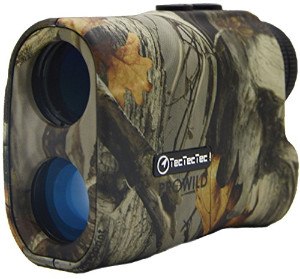 | TecTecTec ProWild |
| CHECK PRICE |
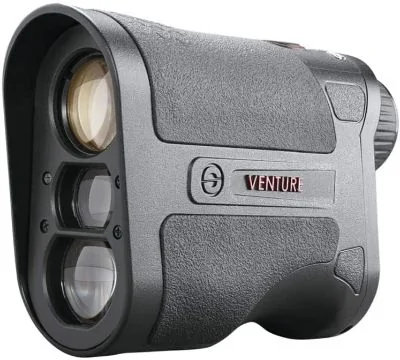 | Simmons Venture |
| CHECK PRICE |
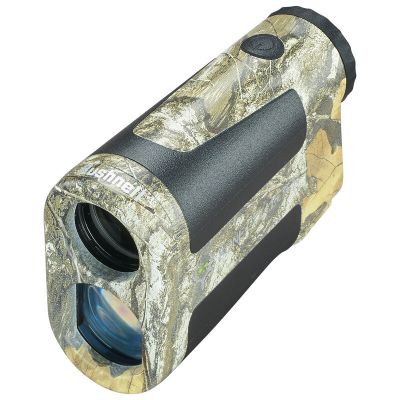 | Bushnell Bone Collector 850 LRF |
| CHECK PRICE |
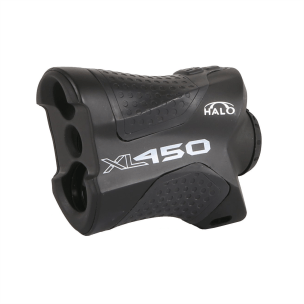 | Halo XL450-7 |
| CHECK PRICE |
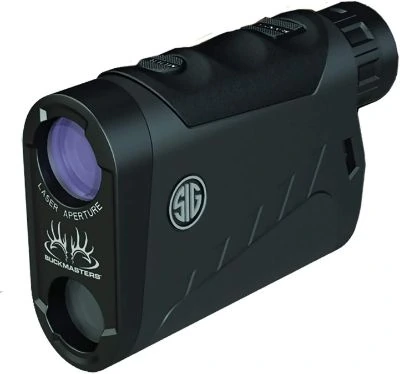 | Sig Sauer Buckmasters 1500 |
| CHECK PRICE |
Our 6 Top Rangefinders Less Than $150
1. Sig Sauer Kilo1000 5x20 – Best Overall
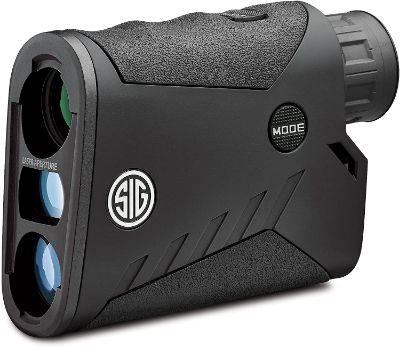
To see a well-established manufacturer in this price range is a rare thing. The Sig Sauer Kilo1000 has finally hit this price point although it may be hit and miss across the board. Finding it for this steal of a deal is worth it every time.
Pros:
- 1200-yard range
- Angle compensation
- LightwaveTM DSP
- SpectraCoatTM
- Compact/lightweight
Cons:
- LCD display
It’s rare to find an OLED (illuminated) display at this price point from a manufacturing authority, so the fact that Sig even has a rangefinder for this price is no room for complaint – just gratitude. Yes, the Kilo1000 has an LCD (black) display, so you will struggle with display visibility in shaded areas and in lowlight.
While it has been outfitted with Lightwave DSP (rangefinding engine) and HyperScan for fast readouts in scan mode with 1200-yard maximum ranging, user reports state that accurate readouts are hard to grab in lowlight conditions.
You can range trees to 800 yards and deer to 600 yards. With AMR technology (inclinometer), angle compensated distances are provided so that you can accurately use the right pin on a bow sight and holdover or dial in the turrets on a scope.
18mm of eye relief may be considered short by some, but it’s within the standard for sufficient eye relief. It has an adjustable diopter to sharpen the display for your vision, and a two-button interface to streamline user-friendly operation.
Made with a polymer housing, it’s strong and lightweight. It’s 3.9 x 2.9 x 1.4” in size and weighs 5.3 oz. Powering the Kilo rangefinder is a CR2 battery for 4000 actuations. The Kilo1000 is easy to use, accurate, and teched-out for its price point. It’s a deal of a buy that you don’t need to be told twice to grab.
2. TecTecTec ProWild - Best Budget Option
- 𝐇𝐔𝐍𝐓𝐈𝐍𝐆 𝐋𝐀𝐒𝐄𝐑 𝐑𝐀𝐍𝐆𝐄𝐅𝐈𝐍𝐃𝐄𝐑: The ProWild Hunting Rangefinder has been crafted masterfully with accuracy...
- 𝐀𝐃𝐕𝐀𝐍𝐂𝐄𝐃 𝐋𝐀𝐒𝐄𝐑 𝐓𝐄𝐂𝐇𝐍𝐎𝐋𝐎𝐆𝐘: This hunting rangefinder provides you with accurate and fast shooting...
For the hunter who needs an instant measurement to the bull that’s going to fill their tag, a dependable rangefinder can fill that gap. For 100 bucks, the TecTecTec ProWild will get it done.
Pros:
- Price
- 540-yard range
- Speed meter
- Compact/lightweight
- Camo finish
Cons:
- Close focus distance
The close focus distance is said to be 5 yards, but a few users have had difficulty measuring down past 50 yards. This could be a problem for close-range shooters, tree stand hunters, and those who shoot small, fast-moving targets. The discrepancy could be due to user error or it could be a defective model.
It has multi-coated optics, 6x magnification, and weather-resistant protection. The finish is an awesome camouflage wrap that will blend in with your hunting gear and the surroundings. With up to 540 yards with accuracy within 1 yard, you’ll be set to holdover if you need to. It also has a Scan Mode, so you can pan the area and get various measurements while you’re waiting for the herd to graze in.
The ProWild also has a Speed Meter mode where you can get a speed measurement of how fast your target is traveling. You’ll be able to see the readings on the LCD display where the aiming reticle is a rectangle box.
It’s very lightweight at only 6.5 oz and is compact in size at 4 x 2.8 x 1.6”. It’s small enough to fit into your camo flap pocket and stay out of sight when you’re busy shootin’.
For the price, the ProWild has proven to be one of the best and dependable rangefinders in the cheap market.
3. Simmons Venture 6x20 Standard – Best for Target Range
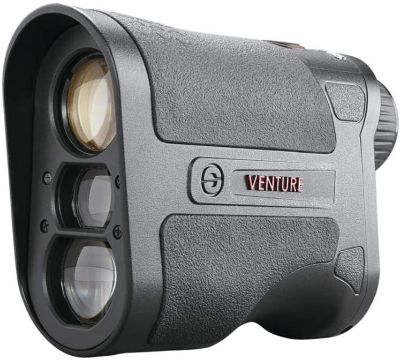
The Venture rangefinder is as simple as it gets. Priced as one of the cheapest rangefinders available with brand-name manufacturer recognition, Simmons is one of the only decent options you can trust.
Pros:
- 6x magnification
- 625-yard range
- Ergonomic design
- Compact
- Lightweight
Cons:
- New model confusion
Simmons SVL620B Venture is a 6x20mm rangefinder with multi-coated optics, -/+ 0.5-yard accuracy, and is the Standard model. It seems like Simmons redid their Venture line as it has a 24mm aperture and no longer takes a 9V battery and coin to open it. Now, it requires a CR2 battery and has a rotating handle to unscrew the battery cap.
Keeping things simple, it has a 625-yard ranging max ranging distance on reflective targets, 480 yards to trees, and 250 yards to deer. This is great for some hunters and especially useful for target shooting at the range.
Keep in mind that the standard version does not have Tilt, aka angle compensation. The Simmons Venture with Tilt model will push you a little over the $150 budget, but it may be worth it for bow or mountain hunting.
It has an open circle as the aiming point with crosshairs that appear while acquiring a range and will disappear when the firing button is released. Pressing through the measuring modes, you can opt for readings in yards or meters. The Venture features a diopter to help sharpen the display for your vision.
This rangefinder has an ergonomic design that allows the thumb to sit comfortably on the underside. While described as bulky by some users, it only has a 4.2” length and weighs 5.8oz.
For fast and accurate distances for close-range work with distant target mode and Scan, the Venture is an affordable option from a recognized sports optics manufacturer.
4. Bushnell Bone Collector 850 LRF

The new Bushnell Bone Collector 850 LRF offers longer ranging, more power, a larger lens, and a new RealTree Edge finish. It has the features you need – nothing more, nothing less.
Pros:
- 6x24 configuration
- 850-yard ranging
- ARC mode
- LCD display
- Compact/lightweight
Cons:
- Loose battery cap
The 850 LRF model sports a new ranging engine that provides instantaneous and accurate readings in Scan, LOS, and ARC modes. The Bone Collector has a minimum 5-yard ranging distance and maximum 850 yards on reflective targets. Distance to trees is 450 yards and deer to 350 yards. Accuracy is guaranteed to be within -/+ 1-yard.
Many treestand, bow, call, and even spot-and-stalk hunters will take their prey inside these distances. Making it suited to bow hunting is its ARC technology that provides distance readings based off inclinometer data. The true horizontal distance and angle is provided to ensure you don’t overshoot and lose the moment. The 850 LRF can measure angles of -/+70-degrees.
Designed to be as inconspicuous as possible, it’s extremely compact at 4.3” in length and 6.35oz in weight. It come with a lanyard but no case, so it will need to stay in a pocket or pouch for protection.
The Bone Collector takes a CR2 battery. Users have said that you need to be deliberate about capping it down correctly and tightly. Problems from neglecting this step is losing the battery cap or intermittent operation during use. If you lose that battery cap, it will be a pain to rig up a solution.
The consensus is, the Bone Collector 850 LRF is an affordable rangefinder with features you’ll actually use and none that you don’t have to pay more for. Backed with the Ironclad Warranty, it lacks nothing for the bow hunter or the sub-400-yard spot-and-stalk chaser.
5. Halo XL450-7 - Best Value
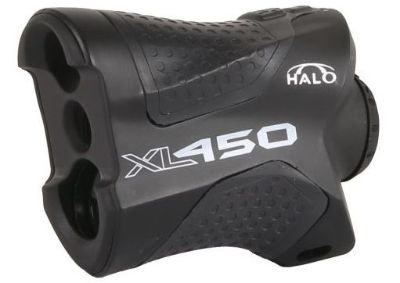
The Halo XL450-7 may be new to 2017, but it's not new to the game. With 450 yards of ranging distance, 6X magnification, and a super-low price tag, it's got everything going for it.
The XL rangefinder continues to stun us all with its premium features that you don't see anywhere else in this budget range. For a basic rangefinder, it turns out it sports more than it should. With angle compensation technology, auto acquisition laser engine, and scan mode included, you'll be hitting readings faster than ever.
The Halo rangefinder is an entry-level unit with pro performance that you shouldn't underestimate. It sports the best price for value and features in a very unique and ergonomic unit. In Halo's words, it turns out that "going back to basics is anything but basic."
6. Sig Sauer Buckmasters 1500 – Best for Hunting
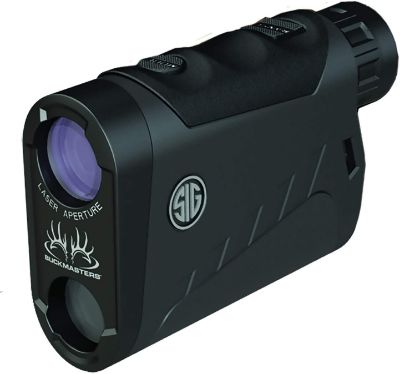
Sig Sauer does it again with a new release, the Buckmasters 1500 rangefinder. Priced affordably for the hunter who wants more for less, the Buckmasters 1500 is a high value rangefinder that must be picked up before it goes out of stock. First in, first serve.
Pros:
- 6x22
- LED display
- 1500-yard range
- 1.5 x 0.2 mrad beam divergence
- Buckmaster Mode
Cons:
- No included case/pouch
The Buckmasters rangefinder is well-equipped with tech and features that is seemingly well above its price point. The 1500 has a 1500-yard max range, 800 to trees, and 600 to deer. It has a 1.5 x 0.2 mrad beam divergence which is very, very good for a budget rangefinder – technically tighter than the 2.0 mrad of the Kilo1000.
It has plenty of modes, maybe too many for the hunter who won’t use them, but plenty enough for the hunter who will. Target modes include Last, Best, First, and you can scan too. On top of that, you have LOS (Line of Sight), AMR (angle compensation), Buckmasters Hold, and MOA Hold ranging modes to make the most of your distance and holdovers.
AMR is accurate up to 400 yards, and the MOA Hold mode will provide a holdover value that can be used with any rifle scope. The 1500 has 8 onboard, predetermined ballistic groups to work with MOA Hold and Buckmasters Hold. The latter mode will provide holdover values to coincide with the correct holdover dot on the Buckmasters rifle scope with the BDC reticle.
Yes, you can get the Buckmasters combo kit that can be found for around $200 and includes the 1500 rangefinder and the 3-9x40 SFP or 3-12x44 riflescope.
For hunters that wanted an illuminated display, a touch more magnification, and some ballistic data, Sig answered that call with the IPX-4 water-resistant Buckmasters 1500. Sig Sauer has set a new standard to budget rangefinders.
What to Look for in a Budget Rangefinder
The nice thing about rangefinders is that you can get away with the principle of "less is more." You can feel free to add custom features like reticles and illumination to your rangefinder, but you could always leave that to your binoculars and rifle scope. The idea of a rangefinder is to give you the distance, and that is its primary function that needs to be done well. What you do want to look at is its accuracy, ease of use, and what it's going to cost you. Here's a few tips to help you on your way.
- Cost: If it's too low, you might be compromising on quality and accuracy.
- Glass: The higher the quality, the better. In this price range, you want to look for clarity.
- Magnification: A 4X or 6X magnification is going to be the norm. The higher power it is, the more difficult it may be to use free-hand. You also might compromise on field of view.
- Ease of use: Look for something that has one-button operation to keep ease of use, well, easy.
- Eye relief: Look for something between 16-20 mm.
- Durability: Weatherproof housing is the best with a quality build. Protect your investment so that you're not at the whims of the sky.
- Accuracy: You want accuracy to be within -/+1 yard.
- Features: It's okay to have a basic rangefinder. If you're gaining features, see if it costs you elsewhere, either in price or in slashing other features that you might end up finding useful.
Less is More!
Rangefinders are simple optic devices, and it should be that way when you're spending less than $150. Keep the quality in this basic functionality to ensure you're getting high performance. If you want the luxury and perks some of the premium rangefinder binoculars have, be prepared to spend more. Otherwise, less is more!
Further Reading




